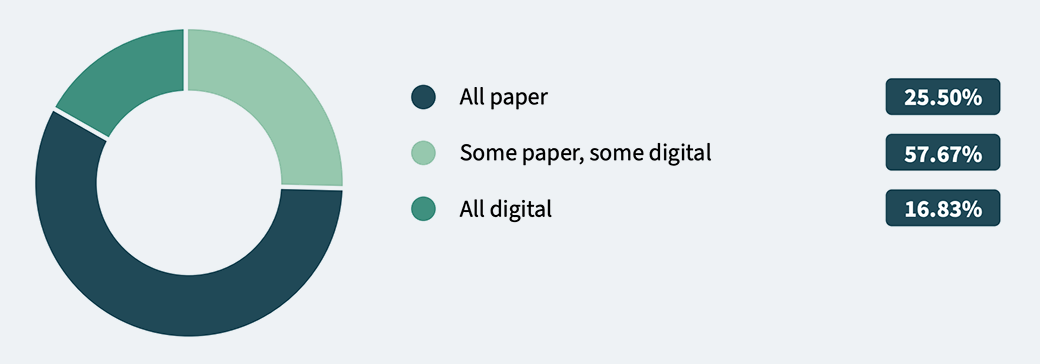
Optimizing the benefits of emerging technologies helps manufacturers drive efficiency and shape the future of their business. In this section, respondents give insights into how much of a priority their companies are placing on embracing new technology, and how they’re sharing it with their workforce.
The exciting evolution of new technology to enhance productivity for manufacturers continues. Of those industry leaders we surveyed, 49% said they’re investing in new technology more than ever, up from 45% last year, while 35% said they’re investing about the same as they have before. Only 16% say they are investing in new technology less than ever, and that number is up from 6% last year.
Respondents from small companies who are investing in new technology more than ever increased from 40% last year to 50% this year. Respondents from large companies who are investing in new technology more than ever dropped from 54% last year to 46% this year.
How has investment in new technology changed at your company over the past 12 months?

Streamlining processes and eliminating excess paper through digitization is happening in manufacturing, albeit slowly. 58% are using a combination of some paper and some digital, while 26% are still using all paper. Only 17% are using all digital documents, although that is up from 13% last year. Slightly fewer companies are using all paper, down from 26% to 31%.
The percentage of smaller companies that are using all digital documents increased from 10% last year to 15% this year, while the percentage of larger companies who have gone all-digital l increased from 18% last year to 23% this year.
Are the forms, lists, schedules, and other documents you work with on a daily basis paper or digital?

Perception matters! Today’s workforce supports technological innovation, and is aware when their current workplaces aren’t keeping up. Of those we surveyed, 39% say their organization is “very modern” while 43% say it’s “somewhat modern” 18% say it’s “not very modern at all.
From last year, those considering their workplace “very modern” decreased from 48% to 39%, while those who say it’s “not very modern at all” increased from 6% to 18%.
Respondents from smaller companies who say their company is “very modern” dropped from 45% last year to 39% this year. Respondents from larger companies who say their company is “very modern” dropped from 53% last year to 36% this year. Younger respondents ages 18 to 34 who say their company is “very modern” dropped from 51% last year to 37% this year.
Compared to other companies in your industry, how "modern" would you say your operation is?

Successful companies not only acknowledge the importance of tech innovation—they welcome it. According to our survey, 48% say their organization is eager to embrace new technology, while 35% say the organization is hesitant to embrace new technology but does so anyway. In contrast, 17% say their organization doesn’t readily embrace new technology.
Compared to last year, those eager to embrace technology dipped a bit, from 50% to 48%. Those who say their organization doesn’t readily embrace new technology rose a small amount, going from 5% to 17%.
Respondents from smaller companies eager to embrace technology increased from 44% last year to 48% this year, while the percentage of respondents from larger companies eager to embrace technology dropped from 63% last year to 44% this year. Younger respondents ages 18 to 34 who say their company is eager to embrace technology dropped from 46% last year to 43% this year.
How would you say your employer has done at embracing new technology?

The top technology respondents’ organizations use is big data (41% —which also topped the list last year.
Other top technologies are 3D printing, robotics or artificial intelligence (AI), and augmented reality.
For companies that are “very modern,” their top tech is big data, 3D printing, and robotics or AI. For companies that are “not very modern at all,” their top tech is augmented reality, 3D printing, and nanotechnology.
What technologies is your factory/plant currently using? [Select all that apply]

On the job usage of new tech is catching on. Our survey found that 70% of respondents used new tools or technologies in their role in the past year.
In smaller companies ,72% of respondents say they’ve used new technology, compared with 64% of respondents from larger companies .
Have you had the opportunity to use any new tools or technologies in your role in the past year?

Once companies integrate these new tools into their processes, they seem to discover the benefits quickly. Our survey found that of those who used new tools, 83% say those new tools or technologies help them perform their work more efficiently.
Among those in smaller companies, 83% of respondents say their efficiency has improved. In larger companies, 80% of respondents say it has.
[If yes] Did these new tools or technologies help you perform your work more efficiently?

In this section, we see a somewhat middle-of-the-road approach to technology in manufacturing. Only half (49%) say their company is investing in new technology more than ever. In assessing where they stand, 39% say their company is “very modern,” and half (48%) say their company is eager to embrace new technology.
While 58% are using a combination of some paper and some digital, only 17% are using all digital documents. And although 70% of those surveyed used new technology this past year, 30% did not—meaning that their company did not bring in new technology in 2023.
When comparing this year’s responses to last year’s report, here’s what stands out:
Ultimately, this shows that while there are many companies embracing technology, eager to use it, and staying at the forefront of emerging technology, there are many who are significantly lagging.